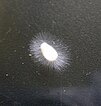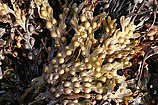Gyrista: Difference between revisions
Appearance
Content deleted Content added
←Created page with '{{Short description|Phylum of eukaryotic organisms}} {{Automatic taxobox|taxon=Gyrista|authority=Cavalier-Smith 1998<ref name="6kingdoms1998"/>|display_parents=4|image={{Multiple image | perrow = 2/2 | total_width = 275 | image1 = Water mold Mizukabi colony.jpg | caption1 = | image2 = Bladder Wrack (Fucus vesiculosus) - geograph.org.uk - 224125.jpg | caption2 = | image3 = Develorapax...' |
(No difference)
|
Revision as of 16:53, 14 November 2022
| Gyrista | |
|---|---|
| Gyristan representatives (clockwise from top-left): water mould, brown algae, diatoms, Develorapax. | |
| Scientific classification | |
| Domain: | Eukaryota |
| Clade: | Diaphoretickes |
| Clade: | TSAR |
| Clade: | SAR |
| Clade: | Stramenopiles |
| Phylum: | Gyrista Cavalier-Smith 1998[1] |
| Classes[2] | |
Gyrista is a phylum of heterokont protists containing two important ecological groups: the highly diverse and mostly photosynthetic Ochrophyta, and the parasitic Pseudofungi, as well as a recently described third group known as Bigyromonada.[2] Members of this phylum are characterized by the presence of a helix or a double helix/ring system in the ciliary transition region.[1]
Gyrista is the sister group to phylum Bigyra, which contains the Sagenista and Opalozoa. Together, Gyrista and Bigyra form the superphylum Stramenopiles or Heterokonta.[3]
References
- ^ a b Cavalier-Smith T (August 1998). "A revised six-kingdom system of life". Biol Rev Camb Philos Soc. 73 (3): 203–266. doi:10.1017/s0006323198005167. PMID 9809012.
- ^ a b Cavalier-Smith, Thomas (2017). "Kingdom Chromista and its eight phyla: a new synthesis emphasising periplastid protein targeting, cytoskeletal and periplastid evolution, and ancient divergences". Protoplasma. 255: 297–357. doi:10.1007/s00709-017-1147-3.
- ^ Derelle R, López-García P, Timpano H, Moreira D (November 2016). "A Phylogenomic Framework to Study the Diversity and Evolution of Stramenopiles (=Heterokonts)". Mol Biol Evol. 33 (11): 2890–2898. doi:10.1093/molbev/msw168. PMC 5482393. PMID 27512113.




